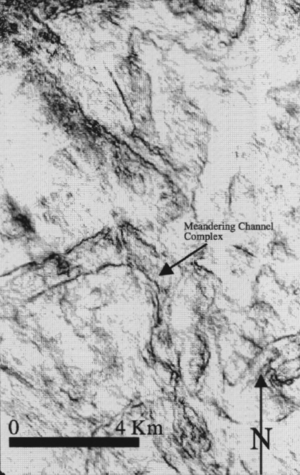Difference between revisions of "Seismic data: analyzing individual reflectors"
(table lists) |
Cwhitehurst (talk | contribs) |
||
| Line 46: | Line 46: | ||
|} | |} | ||
| − | [[file:exploring-for-stratigraphic-traps_fig21-29.png|thumb|{{figure number|1}}.]] | + | ==Reflection strength== |
| + | |||
| + | [[file:exploring-for-stratigraphic-traps_fig21-29.png|thumb|{{figure number|1}}A 3-D coherency slice of a Miocene channel complex in the Nile Delta, Egypt.]] | ||
| − | |||
Reflection strength is a measure of the total energy of a reflection, manifested in reflection amplitude. It is independent of phase. Reflection strength is also referred to as the instantaneous amplitude, or envelope amplitude. Analysis within specific reflectors can give us clues to changes in lithology or [[porosity]]. | Reflection strength is a measure of the total energy of a reflection, manifested in reflection amplitude. It is independent of phase. Reflection strength is also referred to as the instantaneous amplitude, or envelope amplitude. Analysis within specific reflectors can give us clues to changes in lithology or [[porosity]]. | ||
Revision as of 17:01, 25 February 2014
| Exploring for Oil and Gas Traps | |

| |
| Series | Treatise in Petroleum Geology |
|---|---|
| Part | Predicting the occurrence of oil and gas traps |
| Chapter | Exploring for stratigraphic traps |
| Author | John C. Dolson, Mike S. Bahorich, Rick C. Tobin, Edward A. Beaumont, Louis J. Terlikoski, Michael L. Hendricks |
| Link | Web page |
| Store | AAPG Store |
We can enhance our recognition of stratigraphic features by using seismic data attributes, reflection strength, coherence, and instantaneous phase. These attributes are well suited to stratigraphic interpretation and are an effective interpretive tool when displayed in map view.
Seismic data attributes
Seismic data attributes and their use in seismic facies analysis are listed in the following table.
| Attribute | Use |
|---|---|
| Reflection strength |
|
| Instantaneous phase |
|
| 3-D coherence |
|
Reflection strength
Reflection strength is a measure of the total energy of a reflection, manifested in reflection amplitude. It is independent of phase. Reflection strength is also referred to as the instantaneous amplitude, or envelope amplitude. Analysis within specific reflectors can give us clues to changes in lithology or porosity.
Instantaneous phase
Instantaneous phase is an amplitude-independent attribute that highlights reflector continuity. It is useful for enhancing reflector terminations, particularly in areas with weak, low-amplitude events. Reflector terminations appear much clearer, which allows for an easier understanding of the geometry of individual packages of reflectors.
3-D coherence
Three-dimensional coherence is a measure of the similarity of neighboring seismic traces in 3-D data. It is useful for mapping paleogeomorphology and faults.[1]
Figure 1 is a 3-D coherency slice of a Miocene channel complex in the Nile Delta, Egypt.
See also
- Facies analysis
- Basics of seismic facies analysis
- Reflection configuration patterns
- Seismic facies mapping
- Techniques for enhancing seismic facies analysis
- Analyzing lithofacies
- Petrophysical analysis of lithofacies
References
- ↑ Bahorich, M., S., Farmer, S., L., 1995, 3-D seismic discontinuity for faults and stratigraphic features: the coherence cube: The Leading Edge, vol. 14, no. 10, p. 1053–58., 10., 1190/1., 1437077
